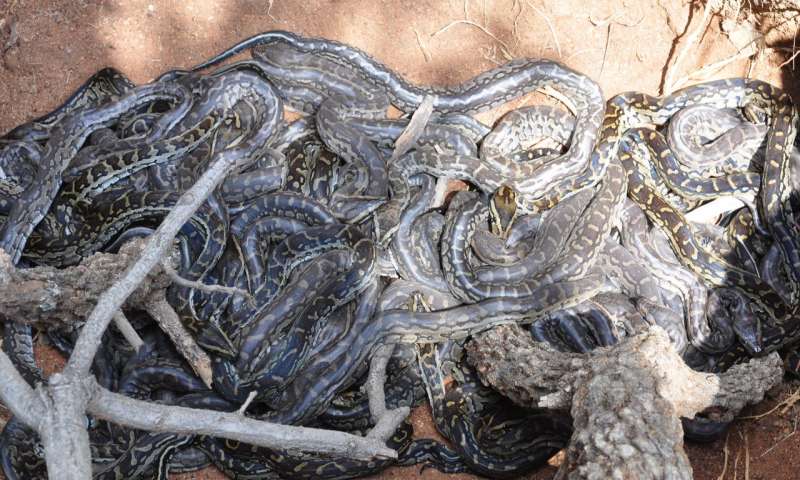When it comes to parental love, snakes don’t top the list. Most snakes just lay their eggs in a safe place, cover them with dirt, and hope for the best. Snakes that give birth to live young still don’t care for them and, overall, you wouldn’t expect snakes to win any parenting awards. But according to a new study, at least one species is truly involved in raising its offspring: the southern African python.

The African rock python (Python natalensis) is one of the 11 living species of python and the largest snake species in Africa. It can be found in a variety of habitats, from forests to near deserts, killing and eating animals as big as an antelope. These pythons are also opportunistic creatures, installing themselves in aardvark burrows for nesting and laying eggs. Professor Graham Alexander, a reptile researcher at the Wits School of Animal Plant and Sciences & the University of the Witwatersrand in Johannesburg, wanted to peek inside these burrows. He installed radio transmitters and infrared cameras inside, following 37 pythons in the Dinokeng Game Reserve, 8 of which laid eggs during the study.
He reports a set of interesting behaviors from the mother pythons. For starters, after they laid eggs, their color tended to become darker. Snakes are unable to regulate their temperature through metabolism, so they bask in the sun and absorb heat — and turning darker allows them to heat up faster. After they raise their temperature (to up to 40 degrees Celsius / 104 Fahrenheit) they slither back to the burrows to keep the eggs warm during the night.
But here’s the interesting thing: they also do the same thing after the snakelets are born, gathering heat during the day, and returning during the night to help keep the young ones warm. They do this for about two weeks before finally departing and leaving the offspring to fend for themselves. This is the first time an egg-laying snake has been observed exhibiting any maternal behavior.
“This is the first-ever report of maternal care of babies in an egg-laying snake,” says Alexander. “I was amazed by the complex reproductive biology of this iconic snake,” said Alexander.
So why do they do it? It’s not particularly clear, though researchers have a few clues. After hatching, the young pythons are still packed full of undigested egg yolk. While this is advantageous, as it means they don’t need to hunt in their earliest days, it also makes them sluggish and vulnerable to predators and cold temperatures. The python mother keeps predators away and also shares her body heat, keeping the youngling warm. This also makes sense, since the study was carried out in the southern range of the snakes, where temperatures are lower than in the other parts of their habitat.
However, this extra care comes at a great price for the mothers: during this period, they are unable to hunt, losing up to 40% of their body weight. Some of them never truly recover, Alexander comments.
“All of this takes its toll on mother pythons: they take a long time to recover after breeding and so can only produce a clutch every second or third year, depending on how many meals they are able to catch in the months after leaving the nest. Some of them never recover.”
Another surprising finding was that male snakes follow receptive females for an impressively long time.
“In one case, one male was recorded following a female for more than 2 km over a three-month period,” says Alexander.
Journal Reference: G. J. Alexander, Reproductive biology and maternal care of neonates in southern African python (Python natalensis), Journal of Zoology (2018). DOI: 10.1111/jzo.12554


